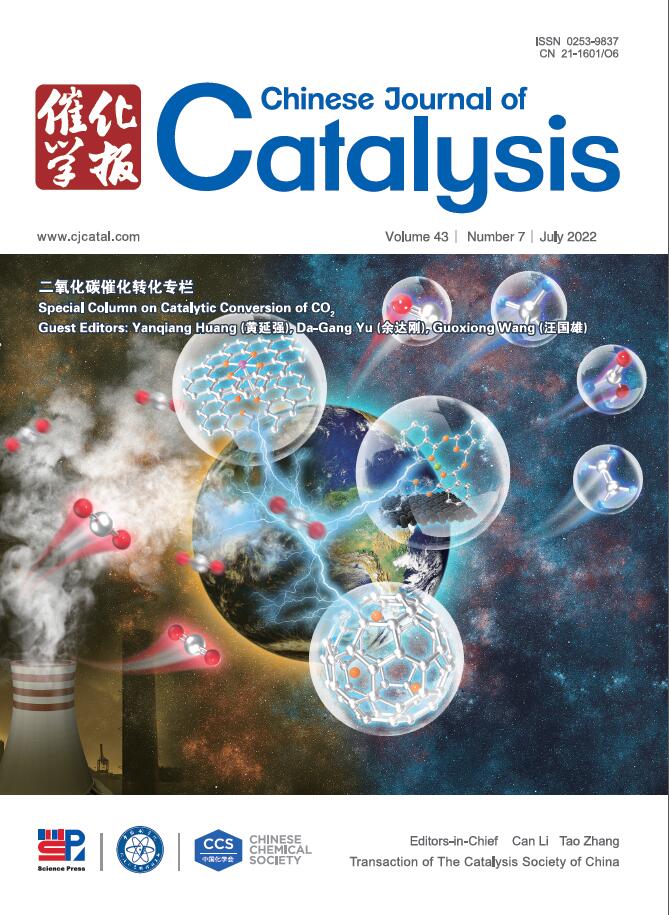Understanding the C–C coupling mechanism in electrochemical CO reduction at low CO coverage: Dynamic change in site preference matters
IF 15.7
1区 化学
Q1 CHEMISTRY, APPLIED
引用次数: 0
Abstract
A thoroughly mechanistic understanding of the electrochemical CO reduction reaction (eCORR) at the interface is significant for guiding the design of high-performance electrocatalysts. However, unintentionally ignored factors or unreasonable settings during mechanism simulations will result in false positive results between theory and experiment. Herein, we computationally identified the dynamic site preference change of CO adsorption with potentials on Cu(100), which was a previously unnoticed factor but significant to potential-dependent mechanistic studies. Combined with the different lateral interactions among adsorbates, we proposed a new C–C coupling mechanism on Cu(100), better explaining the product distribution at different potentials in experimental eCORR. At low potentials (from –0.4 to –0.6 VRHE), the CO forms dominant adsorption on the bridge site, which couples with another attractively aggregated CO to form a C–C bond. At medium potentials (from –0.6 to –0.8 VRHE), the hollow-bound CO becomes dominant but tends to isolate with another adsorbate due to the repulsion, thereby blocking the coupling process. At high potentials (above –0.8 VRHE), the CHO intermediate is produced from the electroreduction of hollow-CO and favors the attraction with another bridge-CO to trigger C–C coupling, making CHO the major common intermediate for C–C bond formation and methane production. We anticipate that our computationally identified dynamic change in site preference of adsorbates with potentials will bring new opportunities for a better understanding of the potential-dependent electrochemical processes.
低CO覆盖下电化学CO还原中C-C耦合机制的研究:位置偏好的动态变化
深入了解界面处的电化学CO还原反应机理,对于指导高性能电催化剂的设计具有重要意义。然而,在机理模拟过程中,由于不注意忽略因素或设置不合理,会导致理论与实验结果出现假阳性。在此,我们通过计算确定了Cu(100)上的电位对CO吸附的动态位点偏好变化,这是一个以前未被注意到的因素,但对电位依赖的机制研究具有重要意义。结合吸附物之间不同的横向相互作用,我们提出了Cu(100)的C-C耦合机制,更好地解释了实验eCORR中不同电位下产物的分布。在低电位下(从-0.4到-0.6 VRHE), CO在桥位形成优势吸附,与另一个吸引聚集的CO偶联形成C-C键。在中电位下(从-0.6到-0.8 VRHE),空界CO占据主导地位,但由于斥力而倾向于与另一种吸附质分离,从而阻碍了耦合过程。在高电位下(高于-0.8 VRHE), CHO中间体由空心co的电还原产生,并有利于与另一个桥- co吸引以触发C-C偶联,使CHO成为C-C键形成和甲烷生成的主要常见中间体。我们预计,我们的计算确定了吸附物的位置偏好随电位的动态变化,将为更好地理解电位依赖的电化学过程带来新的机会。
本文章由计算机程序翻译,如有差异,请以英文原文为准。
求助全文
约1分钟内获得全文
求助全文
来源期刊

Chinese Journal of Catalysis
工程技术-工程:化工
CiteScore
25.80
自引率
10.30%
发文量
235
审稿时长
1.2 months
期刊介绍:
The journal covers a broad scope, encompassing new trends in catalysis for applications in energy production, environmental protection, and the preparation of materials, petroleum chemicals, and fine chemicals. It explores the scientific foundation for preparing and activating catalysts of commercial interest, emphasizing representative models.The focus includes spectroscopic methods for structural characterization, especially in situ techniques, as well as new theoretical methods with practical impact in catalysis and catalytic reactions.The journal delves into the relationship between homogeneous and heterogeneous catalysis and includes theoretical studies on the structure and reactivity of catalysts.Additionally, contributions on photocatalysis, biocatalysis, surface science, and catalysis-related chemical kinetics are welcomed.
 求助内容:
求助内容: 应助结果提醒方式:
应助结果提醒方式:


